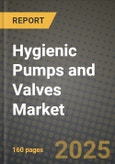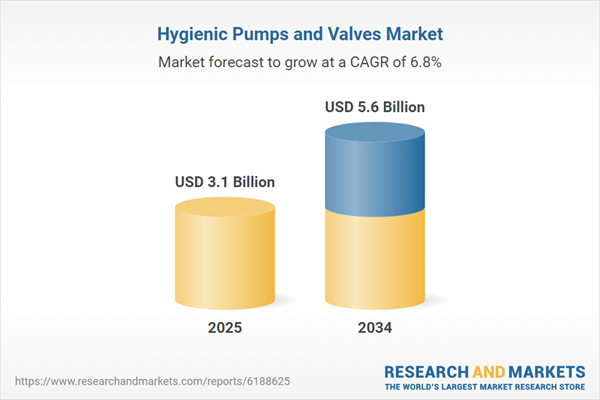The Hygienic Pumps and Valves Market is experiencing strong demand growth across food, beverage, pharmaceutical, and biotechnology industries where product purity, safety, and contamination prevention are critical. These components play a vital role in processing operations by ensuring sterile transfer and flow control of liquids, slurries, and viscous materials. Designed with sanitary materials such as stainless steel and smooth, crevice-free surfaces, hygienic pumps and valves support compliance with stringent global standards like EHEDG, 3-A Sanitary Standards, and FDA regulations. The increasing need for clean-in-place (CIP) and sterilize-in-place (SIP) systems is also contributing to the rising demand. As industries prioritize hygiene, operational efficiency, and regulatory adherence, the market for hygienic fluid handling components is set to grow steadily. Manufacturers are responding with innovations in sealing technology, modularity, and automation to meet evolving customer expectations.
The market witnessed a series of product upgrades focused on performance, durability, and cleanability. Companies introduced advanced valve technologies with fewer dead zones and more robust sealing mechanisms to prevent microbial buildup. Smart pump systems with integrated sensors for real-time flow rate, pressure, and cleanliness monitoring gained significant traction. Food and pharmaceutical manufacturers began modernizing their facilities with hygienic flow systems to meet updated regulatory guidelines, particularly in North America and Europe. Additionally, Asia-Pacific saw a notable surge in demand, led by rapid industrialization and tightening hygiene mandates across processing industries. Mergers and partnerships between fluid handling solution providers and automation firms increased, enhancing product portfolios and enabling smarter, cleaner production lines. Manufacturers also focused on reducing energy consumption and water usage in CIP systems, addressing the dual need for sustainability and hygiene compliance.
The Hygienic Pumps and Valves Market is expected to see continued innovation with a strong emphasis on smart automation and predictive maintenance. The integration of digital twins, AI-based diagnostics, and wireless monitoring technologies will become more widespread, allowing operators to optimize cleaning schedules and anticipate maintenance needs without disrupting production. Equipment manufacturers will likely focus on developing fully customizable, modular valve and pump systems tailored for specific applications in pharma, dairy, brewing, and personal care sectors. As global regulations continue to evolve, the market will see a greater push toward certifiable, eco-friendly designs that support resource conservation while ensuring uncompromised hygiene. Developing markets in Latin America and Southeast Asia are expected to adopt advanced hygienic fluid systems to boost export competitiveness and meet international food and drug safety standards. Investments in R&D, sustainability, and automation will collectively drive the next phase of market evolution.
Key Insights: Hygienic Pumps and Valves Market
- Adoption of smart hygienic pumps and valves with real-time monitoring capabilities is increasing, enabling predictive maintenance and improving operational efficiency in sensitive production environments.
- Energy-efficient pump designs and low-friction valve materials are gaining popularity, aligning with sustainability goals in fluid handling systems.
- Compact and modular valve designs are trending, offering space-saving installation and greater flexibility for system upgrades or expansions.
- Increased integration of hygienic components with clean-in-place (CIP) and sterilize-in-place (SIP) systems is improving cleaning cycles and reducing downtime.
- Manufacturers are developing valves and pumps with advanced sealing technologies to eliminate dead zones and reduce microbial risk.
- Stringent global hygiene and safety standards in food, pharma, and biotech sectors are pushing demand for sanitary fluid handling equipment.
- Growing focus on automation and smart process control is driving adoption of intelligent pumps and valves in processing facilities.
- Expanding demand for processed and packaged food, beverages, and personal care products is fueling investment in hygienic manufacturing systems.
- Technological advancements in cleanability and material science are enabling more durable, efficient, and hygienic equipment designs.
- The high upfront cost of hygienic pumps and valves, along with the complexity of system integration, poses a barrier for small and mid-sized manufacturers with limited capital investment capacity.
Hygienic Pumps and Valves Market Segmentation
By Type
- Hygienic Pumps
- Hygienic Valves
By Pump Type
- Dynamic Pump
- Positive Displacement Pump
By Application
- Dairy
- Processed Food
- Alcoholic Beverage
- Non-Alcoholic Beverage
- Pharmaceutical,Other Applications
By Hygiene Class
- Aseptic
- Standard
- Ultraclean
By Valve
- Single-Seat Valves
- Double-Seat Valves
- Butterfly Valves
- Diaphragm Valves
- Control Valves
- Other Valve Types6) By Material
- Stainless Steel
- Copper
- Bronze
- Other Materials
Key Companies Analysed
- Alfa Laval AB
- Lone Star Fund
- Group Aktiengesellschaft
- ITT Inc.
- Evoguard GmbH
- KSB SE & Co. KGaA
- Emerson Electric Co.
- Spirax-Sarco Engineering plc
- Flowserve Corporation
- Christian Bürkert GmbH & Co. KG
- Gebr. Müller Apparatebau GmbH & Co
- Samson AG
- Fristam Pumpen KG
- Dover Corporation
- Verder International B.V.
- nnovation Diversity and Excellence Corporation
- Adamant Valves
- Bardiani Valvole
- Gebr Rieger GMBH + CO KG
- Curtiss-Wright Corporation
- Ampco Pumps Company
- DEFINOX
- LEWA PUMPS INDIA PRIVATE LIMITED
- Nocado GmbH
- AxFlow Holding AB
- Waukesha Cherry-Burrell
- Adjusted Present Value
- Bornemann Maschinenbau GmbH
- Tapflo Group
- Grundfos Holding A/S
Hygienic Pumps and Valves Market Analytics
The report employs rigorous tools, including Porter’s Five Forces, value chain mapping, and scenario-based modeling, to assess supply-demand dynamics. Cross-sector influences from parent, derived, and substitute markets are evaluated to identify risks and opportunities. Trade and pricing analytics provide an up-to-date view of international flows, including leading exporters, importers, and regional price trends.Macroeconomic indicators, policy frameworks such as carbon pricing and energy security strategies, and evolving consumer behavior are considered in forecasting scenarios. Recent deal flows, partnerships, and technology innovations are incorporated to assess their impact on future market performance.
Hygienic Pumps and Valves Market Competitive Intelligence
The competitive landscape is mapped through proprietary frameworks, profiling leading companies with details on business models, product portfolios, financial performance, and strategic initiatives. Key developments such as mergers & acquisitions, technology collaborations, investment inflows, and regional expansions are analyzed for their competitive impact. The report also identifies emerging players and innovative startups contributing to market disruption.Regional insights highlight the most promising investment destinations, regulatory landscapes, and evolving partnerships across energy and industrial corridors.
Countries Covered
- North America - Hygienic Pumps and Valves market data and outlook to 2034
- United States
- Canada
- Mexico
- Europe - Hygienic Pumps and Valves market data and outlook to 2034
- Germany
- United Kingdom
- France
- Italy
- Spain
- BeNeLux
- Russia
- Sweden
- Asia-Pacific - Hygienic Pumps and Valves market data and outlook to 2034
- China
- Japan
- India
- South Korea
- Australia
- Indonesia
- Malaysia
- Vietnam
- Middle East and Africa - Hygienic Pumps and Valves market data and outlook to 2034
- Saudi Arabia
- South Africa
- Iran
- UAE
- Egypt
- South and Central America - Hygienic Pumps and Valves market data and outlook to 2034
- Brazil
- Argentina
- Chile
- Peru
Research Methodology
This study combines primary inputs from industry experts across the Hygienic Pumps and Valves value chain with secondary data from associations, government publications, trade databases, and company disclosures. Proprietary modeling techniques, including data triangulation, statistical correlation, and scenario planning, are applied to deliver reliable market sizing and forecasting.Key Questions Addressed
- What is the current and forecast market size of the Hygienic Pumps and Valves industry at global, regional, and country levels?
- Which types, applications, and technologies present the highest growth potential?
- How are supply chains adapting to geopolitical and economic shocks?
- What role do policy frameworks, trade flows, and sustainability targets play in shaping demand?
- Who are the leading players, and how are their strategies evolving in the face of global uncertainty?
- Which regional “hotspots” and customer segments will outpace the market, and what go-to-market and partnership models best support entry and expansion?
- Where are the most investable opportunities - across technology roadmaps, sustainability-linked innovation, and M&A - and what is the best segment to invest over the next 3-5 years?
Your Key Takeaways from the Hygienic Pumps and Valves Market Report
- Global Hygienic Pumps and Valves market size and growth projections (CAGR), 2024-2034
- Impact of Russia-Ukraine, Israel-Palestine, and Hamas conflicts on Hygienic Pumps and Valves trade, costs, and supply chains
- Hygienic Pumps and Valves market size, share, and outlook across 5 regions and 27 countries, 2023-2034
- Hygienic Pumps and Valves market size, CAGR, and market share of key products, applications, and end-user verticals, 2023-2034
- Short- and long-term Hygienic Pumps and Valves market trends, drivers, restraints, and opportunities
- Porter’s Five Forces analysis, technological developments, and Hygienic Pumps and Valves supply chain analysis
- Hygienic Pumps and Valves trade analysis, Hygienic Pumps and Valves market price analysis, and Hygienic Pumps and Valves supply/demand dynamics
- Profiles of 5 leading companies - overview, key strategies, financials, and products
- Latest Hygienic Pumps and Valves market news and developments
Additional Support
With the purchase of this report, you will receive:- An updated PDF report and an MS Excel data workbook containing all market tables and figures for easy analysis.
- 7-day post-sale analyst support for clarifications and in-scope supplementary data, ensuring the deliverable aligns precisely with your requirements.
- Complimentary report update to incorporate the latest available data and the impact of recent market developments.
This product will be delivered within 1-3 business days.
Table of Contents
Companies Mentioned
- Alfa Laval AB
- Lone Star Fund
- Group Aktiengesellschaft
- ITT Inc.
- Evoguard GmbH
- KSB SE & Co. KGaA
- Emerson Electric Co.
- Spirax-Sarco Engineering PLC
- Flowserve Corporation
- Christian Bürkert GmbH & Co. KG
- Gebr. Müller Apparatebau GmbH & Co
- Samson AG
- Fristam Pumpen KG
- Dover Corporation
- Verder International B.V.
- nnovation Diversity and Excellence Corporation
- Adamant Valves
- Bardiani Valvole
- Gebr Rieger GMBH + CO KG
- Curtiss-Wright Corporation
- Ampco Pumps Company
- DEFINOX
- LEWA PUMPS INDIA PRIVATE LIMITED
- Nocado GmbH
- AxFlow Holding AB
- Waukesha Cherry-Burrell
- Adjusted Present Value
- Bornemann Maschinenbau GmbH
- Tapflo Group
- Grundfos Holding A/S
Table Information
| Report Attribute | Details |
|---|---|
| No. of Pages | 160 |
| Published | October 2025 |
| Forecast Period | 2025 - 2034 |
| Estimated Market Value ( USD | $ 3.1 Billion |
| Forecasted Market Value ( USD | $ 5.6 Billion |
| Compound Annual Growth Rate | 6.7% |
| Regions Covered | Global |
| No. of Companies Mentioned | 30 |









